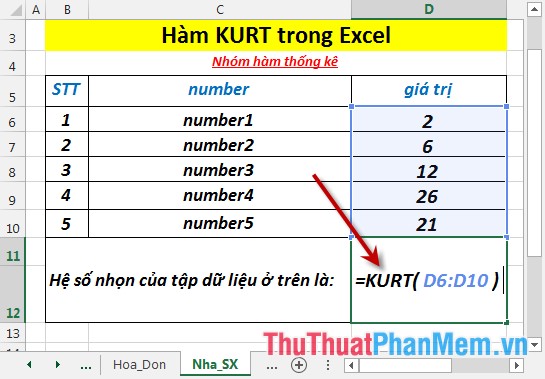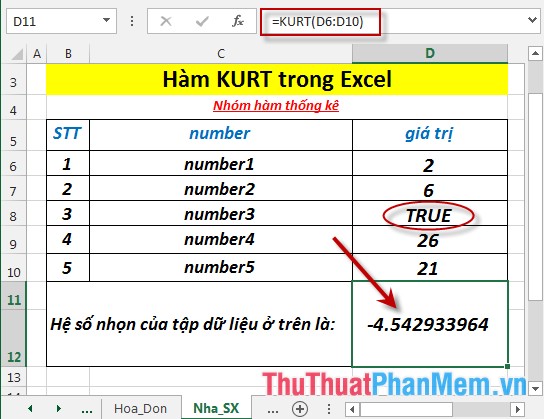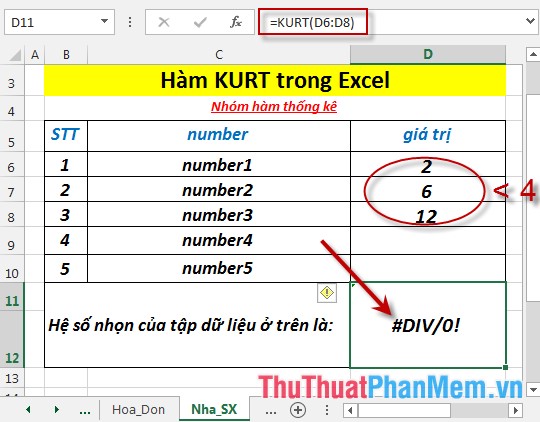KURT function - The function returns the sharp coefficient of a dataset in Excel
The following article introduces you to the KURT function - one of the functions in the statistical function group is very popular in Excel.

Description: The function returns the sharp coefficient of the dataset. Kurtosis indicates the sharp or flat characteristics of a dataset.
- If the positive sharp coefficient -> is relatively pointed distribution.
- If the negative coefficient is negative -> the distribution is relatively flat.
Syntax: KURT (number1, [number2], .)
Inside:
- number1, [number2], .) : Arguments that you want to calculate the coefficient of sharpness, where number1 is the required value, the remaining arguments are optional and contain up to 255 number arguments .
Attention:
- The value of the argument must be a number, name, array or reference containing numbers.
- Logical or text values when typing directly into the argument list -> these values are still counted.
- If the argument is a reference array containing text values or logic -> these values are ignored, but the value 0 is still counted.
- Arguments that are text or error values cannot be converted -> cause errors in the function.
- If the number of data points is less than 4 or the standard deviation is 0 -> the function returns the # DIV / 0 error value
- The kurtosis is determined by the formula:
[left {{frac {{nleft ({n + 1} right)}} {{left ({n - 1} right) left ({n - 2} right) left ({n - 3} right)}} sum {{{left ({frac {{{x_i} - bar x}} {s}} right)} ^ 4}}} right} - frac {{3 {{left ({n - 1} right)} ^ 2 }}} {{left ({n - 2} right) left ({n - 3} right)}}]
Where: s is the sample standard deviation.
For example:
Find the sharp coefficient of the data set in the data table below:

- In the cell to calculate enter the formula : = KURT (D6: D10)

- Press Enter -> the sharp coefficient of the dataset is:

The kurtosis of the above data set is less than 0 -> this data set is distributed flat.
- Where the number of data points of 2 different x and y arrays is logical or text values -> the function ignores these values.

- If the score of the dataset is less than 4 -> the function returns the # DIV / 0 error value

Above are instructions and some specific examples when using the KURT function in Excel.
Good luck!
You should read it
- QUARTILE.EXC function - The function returns the quartile of a dataset without values 0 and 1 in Excel
- CORREL function - The function returns the correlation coefficient between two data sets in Excel
- LARGE function - The function returns the kth largest value in a dataset in Excel
- TRIMMEAN function - The function returns the average of the inner part of a dataset in Excel
- QUARTILE.INC function - The function returns the quartile of a dataset including values 0 and 1 in Excel
- PERCENTRANK.INC function - The function returns the rank of a value in a dataset as a percentage including values 0 and 1 in Excel
- PERCENTRANK.EXC function - The function returns the rank of a value in a dataset as a percentage excluding values 0 and 1 in Excel
- FISHER function - The function returns the Fissher transformation at x in Excel
May be interested
- SMALL function - The function returns the kth smallest value in a dataset in Excel
 small function: the function returns the kth smallest value in a dataset. syntax: small (array, k)
small function: the function returns the kth smallest value in a dataset. syntax: small (array, k) - FISHER function - The function returns the Fissher transformation at x in Excel
 fisher function: the function returns the fissher transformation at x. this transformation creates a normal distribution function, using this function to test a hypothesis based on a correlation coefficient. syntax: fisher (x)
fisher function: the function returns the fissher transformation at x. this transformation creates a normal distribution function, using this function to test a hypothesis based on a correlation coefficient. syntax: fisher (x) - HARMEAN function - The function returns the harmonic average of a data set in Excel
 harmean function: the function returns the harmonic mean of a dataset, the harmonic mean is the reciprocal of the arithmetic mean of the reciprocals. syntax: harmean (number1, [number2], ...)
harmean function: the function returns the harmonic mean of a dataset, the harmonic mean is the reciprocal of the arithmetic mean of the reciprocals. syntax: harmean (number1, [number2], ...) - What is the CORREL function in Excel?
 data can be overwhelming, but excel's correl function helps you cut through the noise. calculating the correlation coefficient is the secret weapon for uncovering hidden trends and making smarter decisions.
data can be overwhelming, but excel's correl function helps you cut through the noise. calculating the correlation coefficient is the secret weapon for uncovering hidden trends and making smarter decisions. - AVEDEV function - The function returns the average absolute deviation of data points from their midpoint in Excel
 avedev function: the function returns the average absolute deviation between a given data point and the average value of the population. the function is a measure of the variability of a dataset
avedev function: the function returns the average absolute deviation between a given data point and the average value of the population. the function is a measure of the variability of a dataset - How to use the NORMDIST function in Excel - Function that returns the distribution in Excel
 the normdist function returns a distribution with a specified mean and standard deviation. the normdist function has applications in statistics, including hypothesis testing.
the normdist function returns a distribution with a specified mean and standard deviation. the normdist function has applications in statistics, including hypothesis testing. - CHISQ.TEST function - The function returns the independence test in Excel
 chisq.test function: the function returns the independence test. the function returns the value from the distribution (({chi ^ 2})) when squared for statistics and the appropriate degrees of freedom. support function from excel 2010 version. syntax: chisq.test (actual_range, expected_range)
chisq.test function: the function returns the independence test. the function returns the value from the distribution (({chi ^ 2})) when squared for statistics and the appropriate degrees of freedom. support function from excel 2010 version. syntax: chisq.test (actual_range, expected_range) - How to use the IF function in Excel
 the if function in excel checks for a true or false condition. if the condition is true, the function returns a value, if the condition fails the function returns another value
the if function in excel checks for a true or false condition. if the condition is true, the function returns a value, if the condition fails the function returns another value - F.TEST function - The function returns the result of the F - test in Excel
 f.test: the function returns the result of the f - test, the probability of two ends where the variance of 2 arrays is not significant. support functions from excel 2010 version. syntax: f.test (array1, array2)
f.test: the function returns the result of the f - test, the probability of two ends where the variance of 2 arrays is not significant. support functions from excel 2010 version. syntax: f.test (array1, array2) - GAMMA function - The function returns the gamma function value in Excel
 gamma: the function returns the gamma function. support functions from excel 2013 onwards. syntax: gamma (number)
gamma: the function returns the gamma function. support functions from excel 2013 onwards. syntax: gamma (number)










 LARGE function - The function returns the kth largest value in a dataset in Excel
LARGE function - The function returns the kth largest value in a dataset in Excel LOGEST - The function returns an array of data that describes an exponential curve that fits the data given in Excel
LOGEST - The function returns an array of data that describes an exponential curve that fits the data given in Excel LOGNORM.DIST - Function returns the logarithmic distribution of x in Excel
LOGNORM.DIST - Function returns the logarithmic distribution of x in Excel LOGNORM.INV function - The function returns the inverse of the logarithmic distribution of x in Excel
LOGNORM.INV function - The function returns the inverse of the logarithmic distribution of x in Excel MAX function - The function returns the largest value in a set of values in Excel
MAX function - The function returns the largest value in a set of values in Excel MAXA function - The function returns the largest value in a set of values including text and logical values in Excel
MAXA function - The function returns the largest value in a set of values including text and logical values in Excel